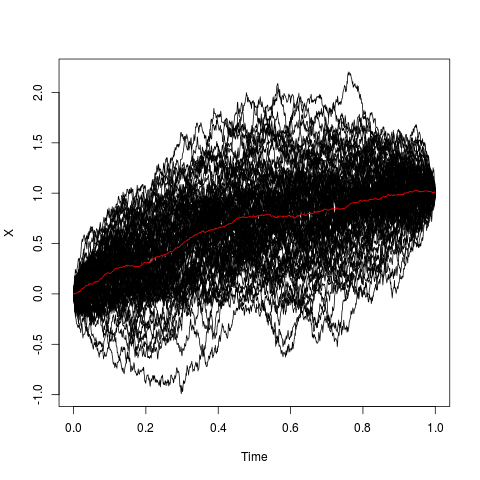Supported by Dr. Osamu Ogasawara and  providing providing  . . |
|
Last data update: 2014.03.03 |
Simulation of 1-Dim Diffusion BridgeDescriptionThe (S3) generic function Usage
bridgesde1d(N, ...)
## Default S3 method:
bridgesde1d(N = 1000, M=1, x0 = 0, y = 0, t0 = 0, T = 1, Dt,
drift, diffusion, alpha = 0.5, mu = 0.5, type = c("ito", "str"),
method = c("euler", "milstein", "predcorr", "smilstein", "taylor",
"heun", "rk1", "rk2", "rk3"), ...)
## S3 method for class 'bridgesde1d'
time(x, ...)
## S3 method for class 'bridgesde1d'
mean(x, ...)
## S3 method for class 'bridgesde1d'
median(x, ...)
## S3 method for class 'bridgesde1d'
quantile(x, ...)
## S3 method for class 'bridgesde1d'
kurtosis(x, ...)
## S3 method for class 'bridgesde1d'
skewness(x, ...)
## S3 method for class 'bridgesde1d'
moment(x, order = 2, ...)
## S3 method for class 'bridgesde1d'
bconfint(x, level=0.95, ...)
## S3 method for class 'bridgesde1d'
plot(x, ...)
## S3 method for class 'bridgesde1d'
lines(x, ...)
## S3 method for class 'bridgesde1d'
points(x, ...)
Arguments
DetailsThe function The methods of approximation are classified according to their different properties. Mainly two criteria of optimality are used in the literature: the strong
and the weak (orders of) convergence. The For more details see Value
Author(s)A.C. Guidoum, K. Boukhetala. ReferencesBladt, M. and Sorensen, M. (2007). Simple simulation of diffusion bridges with application to likelihood inference for diffusions. Working Paper, University of Copenhagen. Iacus, S.M. (2008). Simulation and inference for stochastic differential equations: with R examples. Springer-Verlag, New York See Also
Examples## Ito Bridge sde ## dX(t) = 2*(1-X(t)) *dt + dW(t) ## x0 = 0 at time t0=0 , and y = 1 at time T=1 set.seed(1234) f <- expression( 2*(1-x) ) g <- expression( 1 ) X <- bridgesde1d(drift=f,diffusion=g,y=1,N=1000,M=100) X plot(X,plot.type="single") lines(time(X),mean(X),col=2) Results
R version 3.3.1 (2016-06-21) -- "Bug in Your Hair"
Copyright (C) 2016 The R Foundation for Statistical Computing
Platform: x86_64-pc-linux-gnu (64-bit)
R is free software and comes with ABSOLUTELY NO WARRANTY.
You are welcome to redistribute it under certain conditions.
Type 'license()' or 'licence()' for distribution details.
R is a collaborative project with many contributors.
Type 'contributors()' for more information and
'citation()' on how to cite R or R packages in publications.
Type 'demo()' for some demos, 'help()' for on-line help, or
'help.start()' for an HTML browser interface to help.
Type 'q()' to quit R.
> library(Sim.DiffProc)
Package 'Sim.DiffProc' version 3.2 loaded.
help(Sim.DiffProc) for summary information.
> png(filename="/home/ddbj/snapshot/RGM3/R_CC/result/Sim.DiffProc/bridgesde1d.Rd_%03d_medium.png", width=480, height=480)
> ### Name: bridgesde1d
> ### Title: Simulation of 1-Dim Diffusion Bridge
> ### Aliases: bridgesde1d bridgesde1d.default print.bridgesde1d
> ### time.bridgesde1d mean.bridgesde1d median.bridgesde1d
> ### quantile.bridgesde1d kurtosis.bridgesde1d skewness.bridgesde1d
> ### moment.bridgesde1d bconfint.bridgesde1d plot.bridgesde1d
> ### points.bridgesde1d lines.bridgesde1d
> ### Keywords: sde ts mts
>
> ### ** Examples
>
> ## Ito Bridge sde
> ## dX(t) = 2*(1-X(t)) *dt + dW(t)
> ## x0 = 0 at time t0=0 , and y = 1 at time T=1
> set.seed(1234)
>
> f <- expression( 2*(1-x) )
> g <- expression( 1 )
> X <- bridgesde1d(drift=f,diffusion=g,y=1,N=1000,M=100)
> X
Ito Bridges Sde 1D:
| dX(t) = 2 * (1 - X(t)) * dt + 1 * dW(t)
Method:
| Euler scheme of order 0.5
Summary:
| Size of process | N = 1000.
| Crossing realized | C = 86.
| Initial value | x0 = 0.
| Final value | y = 1.
| Time of process | t in [0,1].
| Discretization | Dt = 0.001.
> plot(X,plot.type="single")
> lines(time(X),mean(X),col=2)
>
>
>
>
>
> dev.off()
null device
1
>
|
